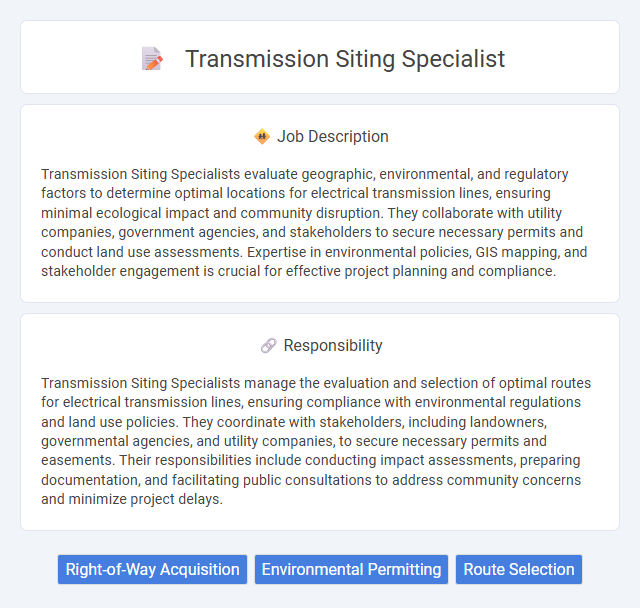
Transmission Siting Specialists evaluate geographic, environmental, and regulatory factors to determine optimal locations for electrical transmission lines, ensuring minimal ecological impact and community disruption. They collaborate with utility companies, government agencies, and stakeholders to secure necessary permits and conduct land use assessments. Expertise in environmental policies, GIS mapping, and stakeholder engagement is crucial for effective project planning and compliance.
Individuals with strong problem-solving skills and an ability to navigate complex regulatory environments are likely to be well-suited for a Transmission Siting Specialist role. Those comfortable working outdoors in varied weather conditions and engaging with diverse stakeholders may find this job aligns with their preferences and strengths. Candidates who prefer routine office work or resist travel might face challenges adapting to the demands of this position.
Qualification
Transmission Siting Specialists typically require a bachelor's degree in environmental science, engineering, urban planning, or a related field, combined with experience in regulatory compliance and land use planning. Proficiency in GIS software, knowledge of federal and state transmission siting regulations, and strong stakeholder communication skills are crucial for effective project execution. Certifications such as Professional Engineer (PE) or Certified Environmental Professional (CEP) can enhance qualifications and career advancement opportunities.
Responsibility
Transmission Siting Specialists manage the evaluation and selection of optimal routes for electrical transmission lines, ensuring compliance with environmental regulations and land use policies. They coordinate with stakeholders, including landowners, governmental agencies, and utility companies, to secure necessary permits and easements. Their responsibilities include conducting impact assessments, preparing documentation, and facilitating public consultations to address community concerns and minimize project delays.
Benefit
A Transmission Siting Specialist likely provides essential benefits by ensuring the optimal placement of transmission lines to minimize environmental impact and reduce community disruption. They probably enhance project efficiency by navigating regulatory requirements and securing necessary permits, which can help prevent costly delays. Their expertise might contribute to improved stakeholder relations through clear communication and addressing local concerns, leading to smoother project execution.
Challenge
Transmission Siting Specialists likely encounter significant challenges involving complex regulatory environments and community opposition when identifying optimal locations for power lines. Navigating environmental impact assessments and negotiating with multiple stakeholders probably require strong problem-solving skills and adaptability. The role may also demand balancing technical requirements with legal constraints, increasing the intricacy of project execution.
Career Advancement
Transmission Siting Specialists play a crucial role in the planning and permitting of electrical transmission lines, leveraging expertise in environmental regulations and stakeholder engagement. Career advancement often leads to senior project management roles or specialized positions in regulatory compliance, where managing complex infrastructure projects and navigating multi-jurisdictional approvals are key. Growth opportunities also include transitioning into strategic planning or consultancy roles that influence energy policy and transmission network development.
Key Terms
Right-of-Way Acquisition
A Transmission Siting Specialist with expertise in Right-of-Way Acquisition ensures efficient land access for utility infrastructure by negotiating easements and coordinating with landowners, government agencies, and stakeholders. Mastery of property law, environmental regulations, and GIS mapping tools enables accurate site assessment and risk mitigation. This role is critical to facilitating timely project approvals and minimizing delays in power transmission development.
Environmental Permitting
Transmission Siting Specialists coordinate environmental permitting processes to ensure compliance with federal, state, and local regulations during the planning and construction of electrical transmission lines. They conduct detailed environmental impact assessments, prepare permit applications, and liaise with regulatory agencies to secure necessary approvals. Expertise in environmental laws such as the National Environmental Policy Act (NEPA) and Endangered Species Act (ESA) is critical to successfully navigating transmission project siting challenges.
Route Selection
Transmission Siting Specialists conduct comprehensive route selection analyses to identify optimal pathways for power lines, balancing environmental impact, land use, and regulatory compliance. They utilize Geographic Information Systems (GIS) and field surveys to evaluate potential corridors, ensuring minimal disruption to communities and ecosystems. Their expertise supports utility companies in securing permits and advancing projects efficiently through complex permitting processes.
 kuljobs.com
kuljobs.com